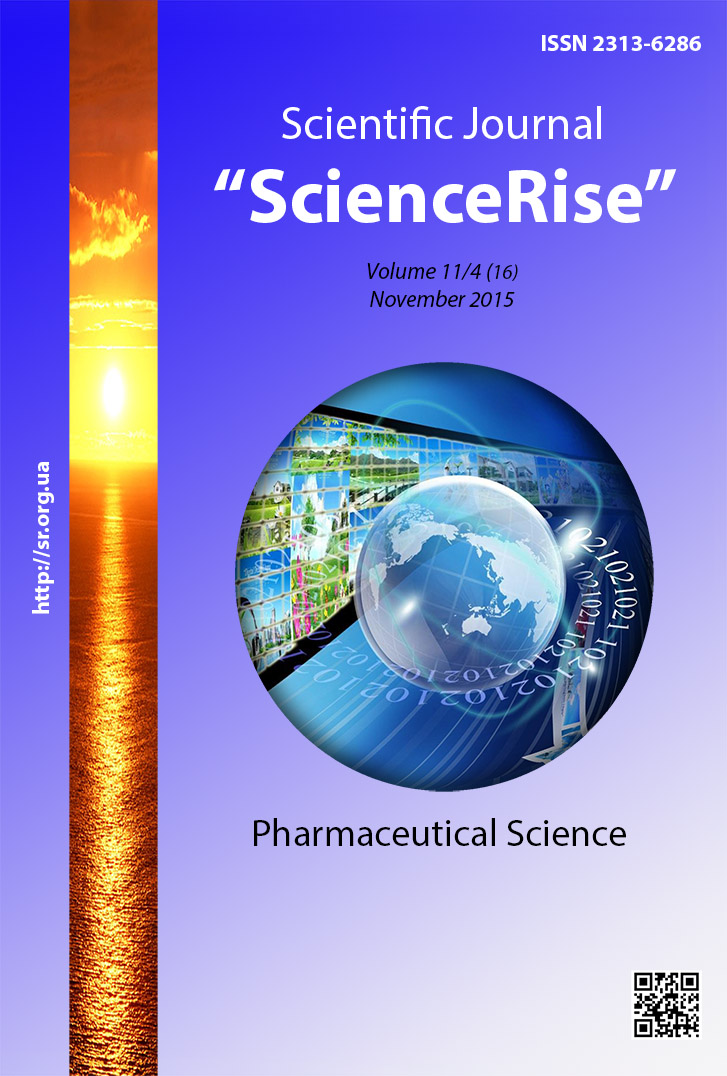Phytochemical study of phenolic compounds of labrador tea (Lédum palústre L.)
DOI:
https://doi.org/10.15587/2313-8416.2015.54483Keywords:
Labrador Tea, sesquiterpene alcohols, coumarins, flavonoids, aglycones, catechins, hydroxycinnamic acidAbstract
Aim. This work is devoted a phytochemical study of biologically active substances in herb of Labrador Tea (Lédum palústre L.), as well as investigation of the possibility of complex use of raw materials in order to create on its basis new herbal medicines.
Methods. The object of the study served as the herb Labrador Tea. Separation of isolated substances was performed by adsorption and partition chromatography on various adsorbents. The structure of the isolated compounds was determined based on physicochemical methods: paper (PC) and the thin layer (TLC) chromatography, UV, IR and NMR spectroscopy in comparison with the original valid standards of flavonoids. Acid hydrolys was used for the determination of the flavonoid aglycone composition. The content of total flavonoids was determined by differential spectrophotometry at a wavelength of 412 nm from the reaction with aluminum chloride based on the hyperoside-standard (Ukrainian scientific Pharmacopoeial center for quality of medicines (Pharmacopoeial center), Kharkоv).
Results. During this study we found more than 40 of phenolic compounds and identified 31compounds. The phytochemical analysis showed the presence of flavonols (11 compounds), catechins (5). Hydroxycinnamic acids represented by caffeic, ferulic, chlorogenic acids. Besides that, it were found phenolic glycoside arbutin, coumarins - coumarin, umbelliferon, scopoletin, esculetin and esculin, tannins – metyl gallate, pyrogallol.
Conclusions. The following biologically active substances were defined for the first time: flavonoids – 5-methyl-kaempferol, avicularin, polistahozid, quercitrin; coumarins – esculetin, esculin; as well as hydroxycinnamic acids – ferulic, chlorogenic, neochlorogenic of Labrador Tea. The obtained data justify the prospectivefor creation of new and effective herbal medicines from Labrador Tea
References
Monografii VOZ o lekarstvennyh rastenijah, shiroko ispol'zuemyh v Novyh nezavisimyh gosudarstvah (NNG) (2010). Vsemirnaja organizacija zdravoohranenija, 165–178. Available at: http://www.who.int/medicines/areas/traditional/monograph_russian.pdf
Action plan for herbal medicines 2010–2011. European Medicines Agency. Available at: http://www.ema.europa.eu/docs/en_GB/document_library/Other/2010/06/WC500093179.pdf
Bannerman, R. H. (1982). Traditional medicine in modern health care. World Health Forum, 3, 8–13.
Rates, S. M. (2001). Plants as source of drugs. Toxicon, 39 (5), 603–613. doi: 10.1016/s0041-0101(00)00154-9
Garnyk, T. P., Tumanov, V. A., Pokanevych, V. V. (2012). Fitoterapija: suchasni tendencii' do vykorystannja v likars'kij praktyci ta perspektyvy podal'shogo rozvytku. Fitoterapija, 1, 4–11.
Harmaja, H. (1990). New names and nomenclatural combinations in Rhododendron (Ericaceae). Ann. Bot. Fenn, 27, 203–204. Available at: http://www.ars-grin.gov/cgi-bin/npgs/html/taxon.pl?410675
Grodzins'kyj, A. M.; Grodzins'kiy, A. M. (Ed.) (1990). Líkars'ki roslýny: Encyklopedýchnyj. Kyiv: Golov. red. URE, 544.
Minarchenko, V. M. (1997). Stan ta vykorystannja resursiv dykoroslyh likars'kyh roslyn Ukrai'ny. Ohor. navkol. pryrod, sered, v Ukrai'ni 1994–1995. Kyiv: Vyd-vo Rajevs'kogo, 30–32.
Chopik, V. I., Krasnova, A. N. (1983). Dikorastushhie poleznye rastenija Ukrainy. Kyiv: Nauk. dumka, 18–19.
Serbin, A. G., Sira, L. M., Slobodjanjuk, T. O.; Sira, L. M. (Ed.) (2015). Farmacevtychna botanika. Vinnyca: NOVA KNYGA, 420.
Maksjutina, N. P., Komissarenko, N. F., Prokopenko, A. P. et. al; Maksjutina, N. P. (Ed.) (1985). Rastitel'nye lekarstvennye sredstva. Kyiv: Zdorov'ja, 280.
Kompendium 2015. Lekarstvennye preparaty. – Available at: http://compendium.com.ua/atc/R05#R05C_A22**
Belousova, N. I., Han, V. A., Tkachev, A. V. (1999). Himicheskij sostav jefirnogo masla bagul'nikov. Himija rastitel'nogo syr'ja, 3, 5–38.
Upyr, T. V., Komisarenko, A. M., Koshovyj, O. M. (2014). Terpenoi'dnyj sklad efirnoi'olii' travy Ledum palustre. Farmhimija ta farmakognozija, 23 (4), 408–412.
Levashova, O. L., Gaponenko, V. P. (2015). Poisk i sozdanie anal'getikov prirodnogo proishozhdenija. Svіt medicini ta bіologіi, 2 (50), 144–146. Available at: http://repo.knmu.edu.ua/bitstream/123456789/9565/1/%D0%B0%D0%BD%D0%B0%D0%BB%D1%8C%D0%B3%D0%B5%D1%82%D0%B8%D0%BA%D0%B8%20%D0%BF%D1%80%D0%B8%D1%80%D0%BE%D0%B4%D0%BD%D0%BE%D0%B3%D0%BE%20%D0%BF%D1%80%D0%BE%D0%B8%D1%81%D1%85.pdf
Petruhina, A. A. (2003). Flavonoidy kak aktivnoe nachalo lekarstvennyh rastenij. Kosmetika i medicina, 3, 40–49.
Mirsalihova, N. M., Pakudina, Z. P. (1977). Flavonoidy – ingibitory Na+, K+ – ATF-azy. Himija prirodnyh soedinenij, 1, 44–45.
Dranik, L. I. (1968). O fenol'nyh soedinenijah nekotoryh rastenij semejstva slozhnocvetnyh. Artishok (Cynarascolymus L.). Fenol'nye soedinenija i ih biologicheskie funkcii. Moscow, 53–60.
Georgievskij, V. P., Komisarenko, N. F., Dmitruk, S. E. (1990). Biologicheski aktivnye veshhestva lekarstvennyh rastenij. Novosibirsk: Nauka, Sibirskoe otdelenie, 336.
Zapromjotov, M. N. (1964). Biohimija katehinov. Moscow, 294.
Cancer. Factsheet № 297. World Health Organization (WHO). Available at: http://www.who.int/mediacentre/factsheets/fs297/en/
Downloads
Published
Issue
Section
License
Copyright (c) 2015 Валентина Петровна Гапоненко, Ольга Леонидовна Левашова

This work is licensed under a Creative Commons Attribution 4.0 International License.
Our journal abides by the Creative Commons CC BY copyright rights and permissions for open access journals.
Authors, who are published in this journal, agree to the following conditions:
1. The authors reserve the right to authorship of the work and pass the first publication right of this work to the journal under the terms of a Creative Commons CC BY, which allows others to freely distribute the published research with the obligatory reference to the authors of the original work and the first publication of the work in this journal.
2. The authors have the right to conclude separate supplement agreements that relate to non-exclusive work distribution in the form in which it has been published by the journal (for example, to upload the work to the online storage of the journal or publish it as part of a monograph), provided that the reference to the first publication of the work in this journal is included.

